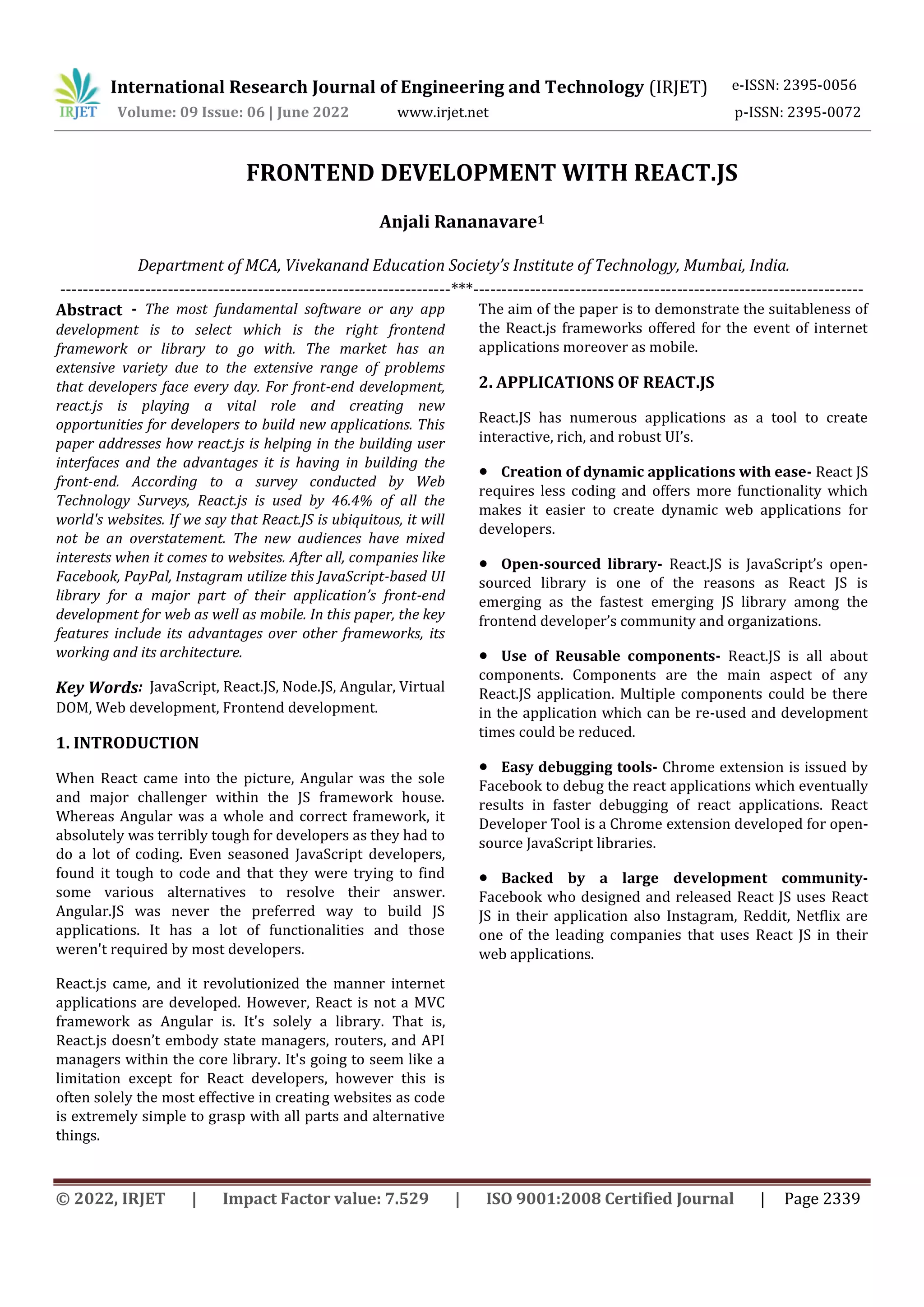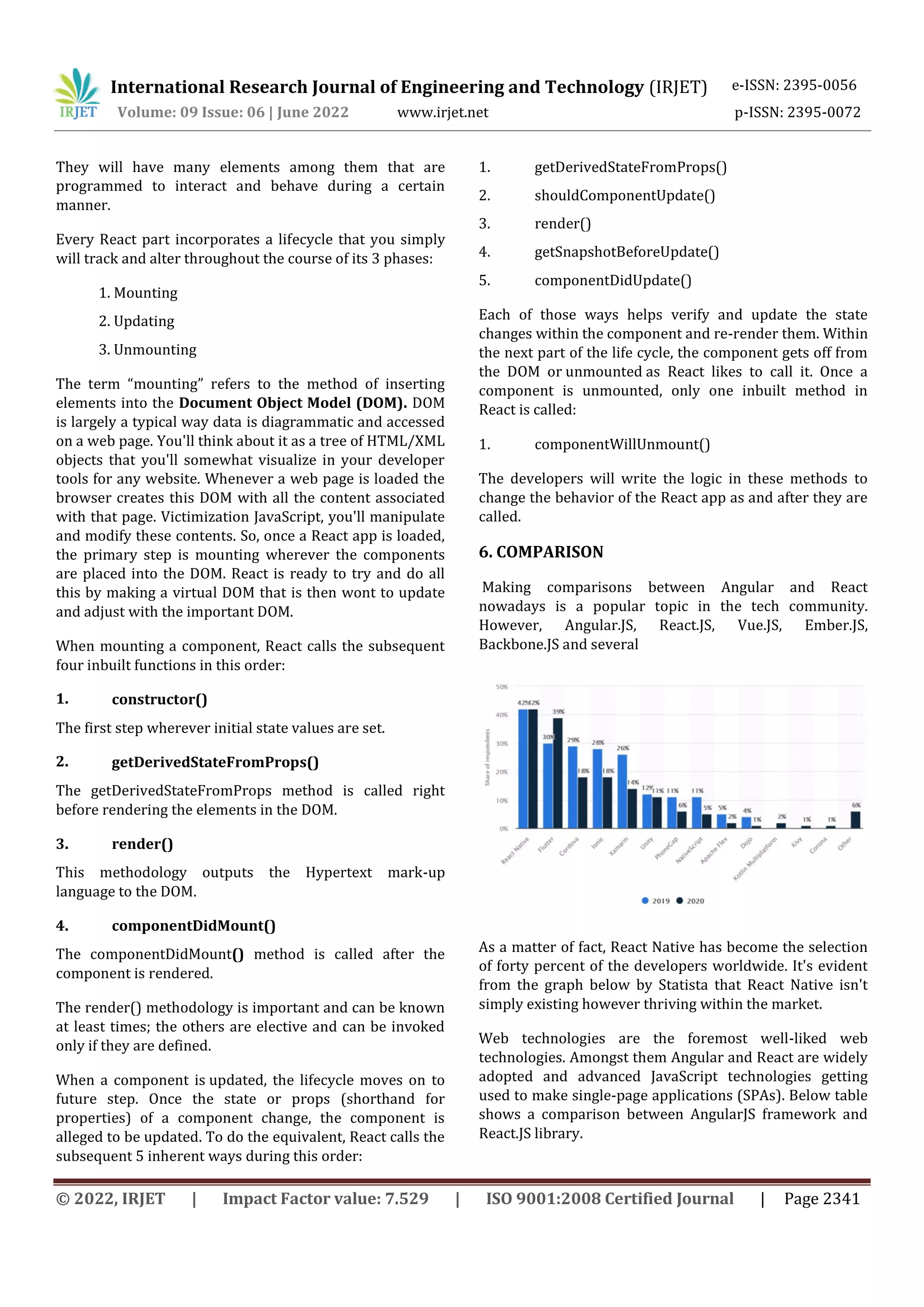This document discusses React.js and its use for frontend development. It covers the key features and advantages of React, how it works, its architecture including components and the virtual DOM, comparisons to other frameworks like Angular, and examples of companies that use React like Facebook and Netflix. The summary is: React.js is a popular library for building user interfaces that uses reusable components and a virtual DOM for improved performance. It has advantages over frameworks like Angular in being easier to learn and use due to its simpler architecture and unidirectional data flow. Major companies like Facebook use React for significant parts of their applications, demonstrating its widespread adoption.



![International Research Journal of Engineering and Technology (IRJET) e-ISSN: 2395-0056 Volume: 09 Issue: 06 | June 2022 www.irjet.net p-ISSN: 2395-0072 © 2022, IRJET | Impact Factor value: 7.529 | ISO 9001:2008 Certified Journal | Page 2342 As shown in Table, there are some fundamental differences between AngularJS and React in terms of data binding, dependency handling, DOM manipulation and languages they use. But the biggest difference is that Angular JS is a framework whereas ReactJS is a library. Though, both of them are used for front-end development. Many businesses, news, travel, social networking companies in the USA, the UK, Asia, France, Germany, Canada and many other countries are using both React and Angular. Angular is very popular among the developers as it is a complete framework which comes with MVC (Model-View-Controller) while React is a library, not a framework. 7. CONCLUSION React.Js framework can be used for building beautiful User Interfaces by implementing some core JavaScript features. It is easy to use and implement as it provides us with a mark-up syntax that is closely related to HTML [8]. Virtual DOM is the most important feature which prevents reloading of a page and increases the overall efficiency of our application. As our application is built over JavaScript, it also provides us with a package manager called NPM, which provides an easier way of installing external dependencies. To alter the lifecycle of our class components, React provides us with lifecycle methods. React Hooks also provides us with the same functionalities but is built for our functional components. React is one of the most widely used frameworks that is being used by many developers for building applications or interfaces. Thus the demand for this framework and its functionalities will definitely grow in the near future. React is that library assisting companies to achieve their goals, fortifying its relevance in the market for a longer time to come. REFERENCES “React JS: An Open-Source JavaScript Library for Front-end Development” by Naimul Islam Naim. https://reactjs.org/tutorial/tutorial.html https://en.wikipedia.org/wiki/React_(JavaScript _library) ReactJS.org,’ ReactJS official'. [Online]. Krunal Shah, “Top 14 React Libraries you must try in 2020” Wikipedia.org, 'React (JavaScript Library)'. [Online]. Available: https://en.wikipedia.org/wiki/React_(JavaScript _library). [Accessed: Feb- 2018] COMPARATIVE ANALYSIS OF ANGULARJS AND REACTJS Anurag Kumar and Ravi Kumar Singh International Journal of Latest Trends in Engineering and Technology Vol.(7)Issue(4), pp.225-227 DOI: http://dx.doi.org/10.21172/1.74.030 e- ISSN:2278-621X https://www.simform.com/why-use-react/ https://www.javatpoint.com/react- features Prof. B. A. Khivsara, Umesh Khivsara, “Design and Implementation of Single Page Application Based on AngularJS,” 6th International Conference on Recent Trends in Engineering & Technology (ICRTET - 2018).](https://image.slidesharecdn.com/irjet-v9i6436-221017061203-c97d44c0/75/FRONTEND-DEVELOPMENT-WITH-REACT-JS-4-2048.jpg)